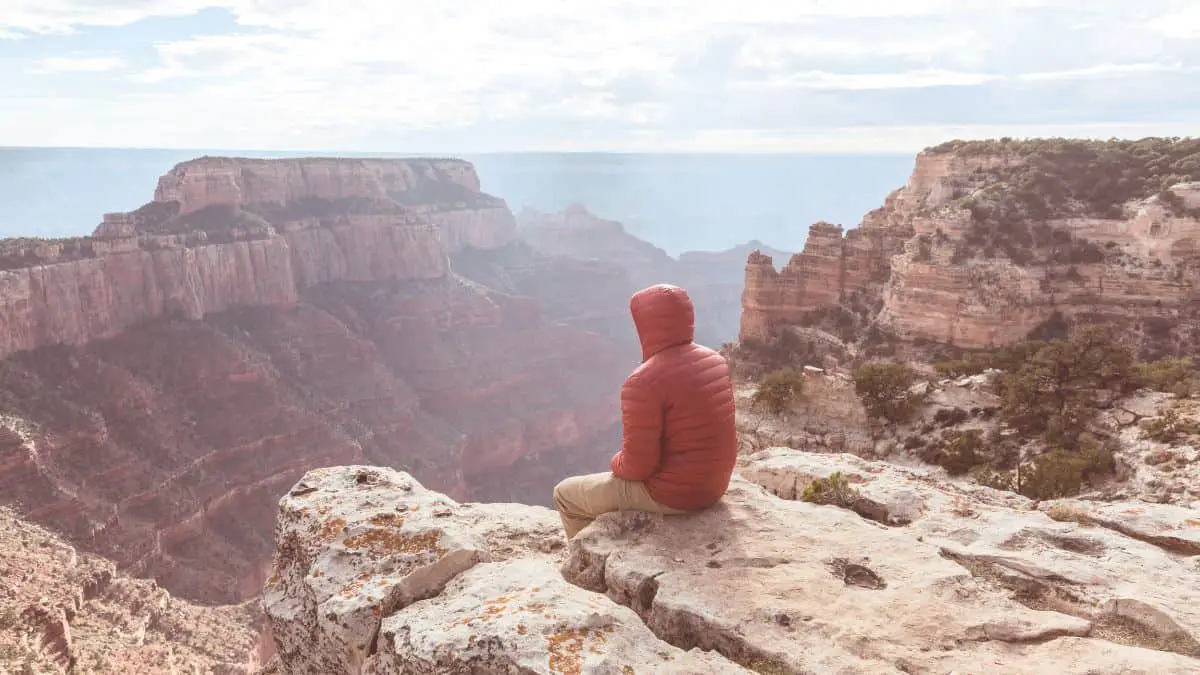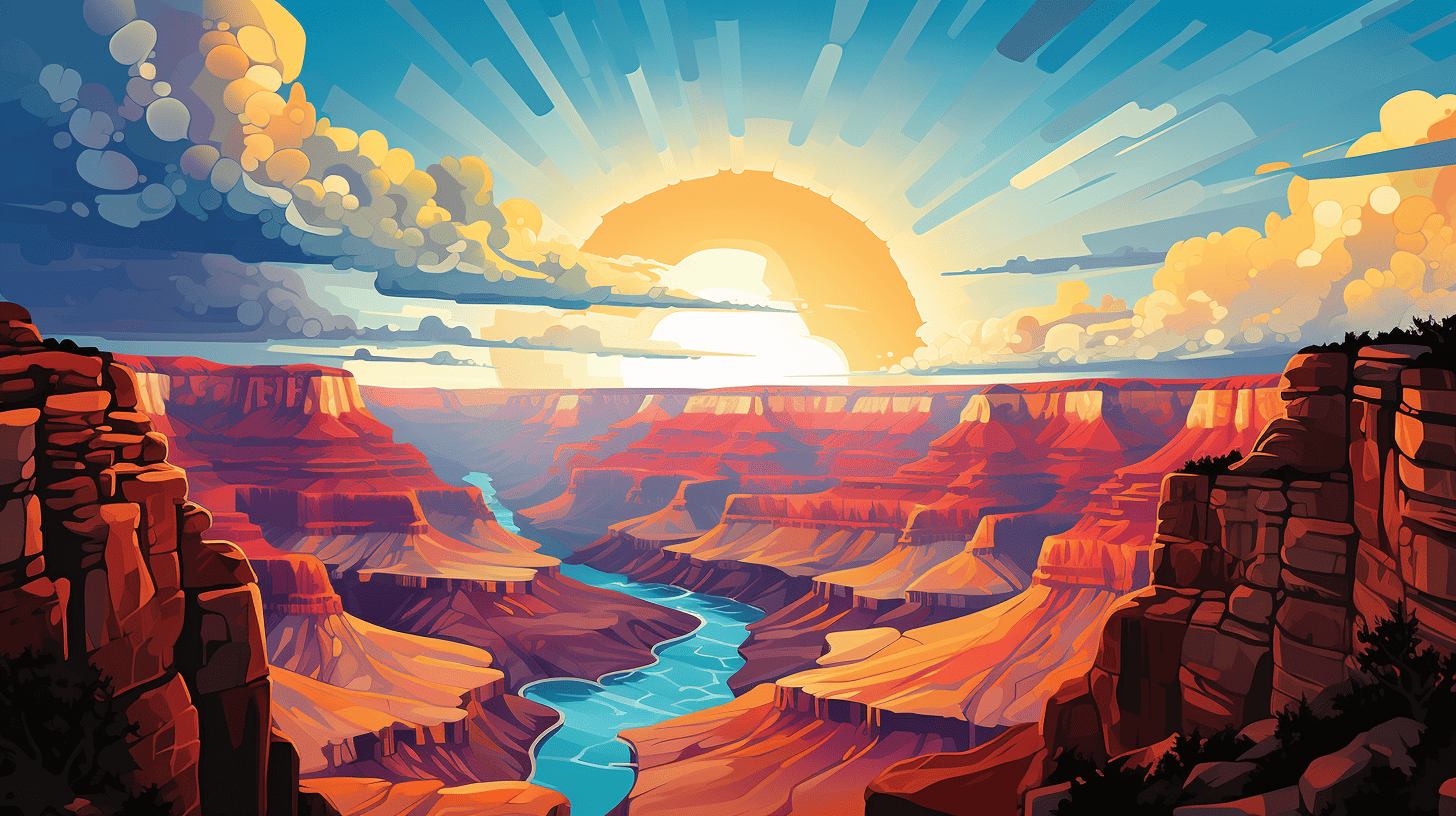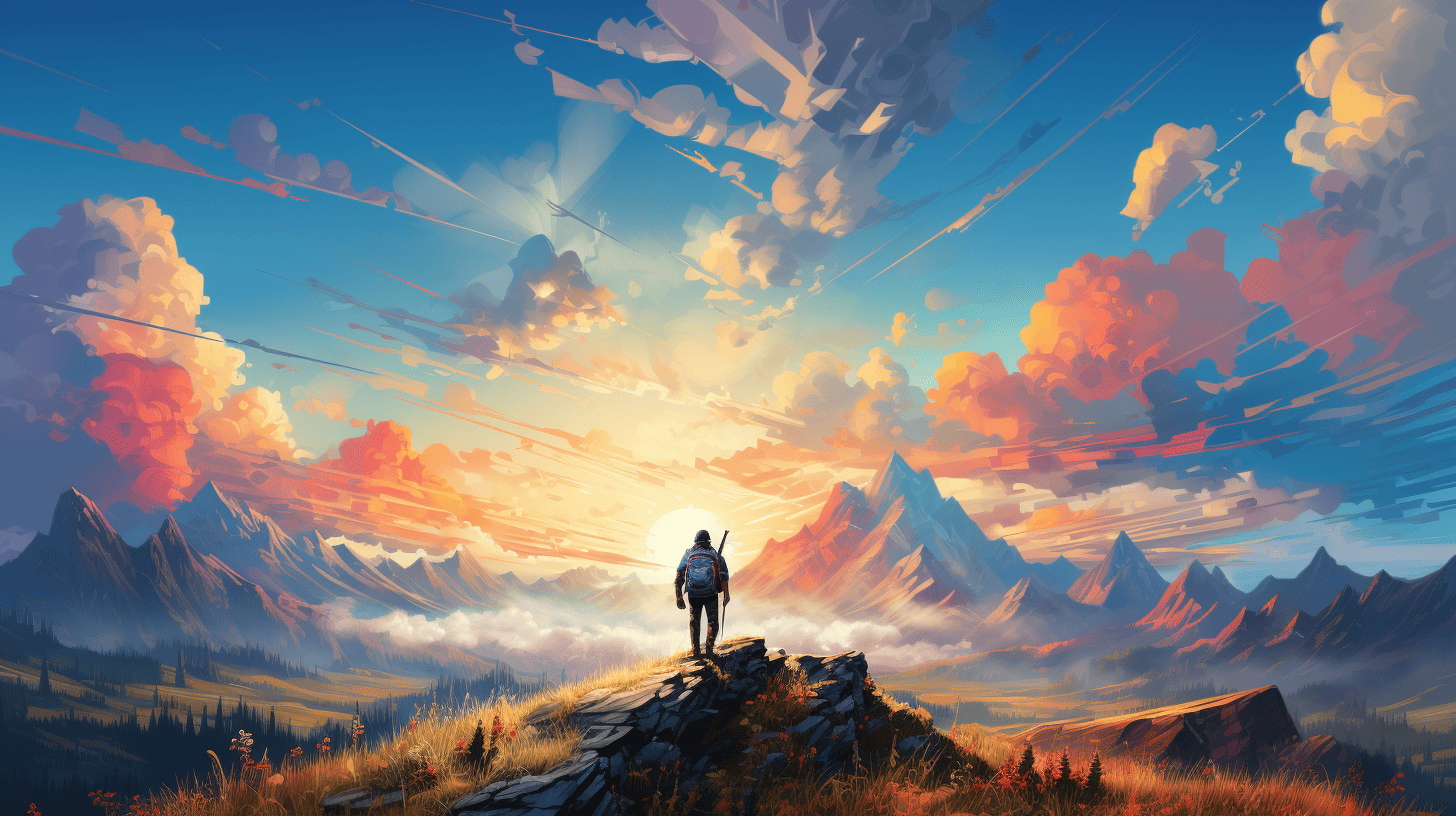Backpacking Trips In The Grand Canyon - Complete Guide
If you click and purchase with one of our links, we earn a commission. Thanks.

The Grand Canyon is a natural wonder that backpackers and adventure seekers hold dear. It’s a place where you can soak in the beauty of nature and challenge yourself with a rigorous hike.
My friend Dr. Tom spent the last 15 years of his life going on an annual trip to backcountry of the canyon. While he often drove his pickup truck for his weeklong trips, he inspired me to dream of pushing myself.
His trip diaries also reminded me to take the Canyon seriously. Do not go into the Grand Canyon unprepared. Make sure you are carrying at least the 5 C’s of survival.
If you’re planning your first backpacking trip to the Grand Canyon, you’ll need the right information to ensure a successful trip. This comprehensive guide has you covered.
We’ll take you through the best routes, essential gear, and safety tips you need to know before hitting the trails. We’ll also discuss the best time to visit and the permits required for backpacking in the Grand Canyon.
Discover hidden gems and lesser-known trails that will make your adventure unforgettable. Whether you’re a seasoned backpacker or just starting, the Grand Canyon has something for everyone.
Before you get started, don’t forget to check out our list of backpacking gear.
Key Takeaways
- Backpacking in the Grand Canyon offers a unique and immersive extopperience in nature.
- Proper gear is essential for a safe and successful backpacking trip in the Grand Canyon.
- Permits and camping regulations are required for backpacking in the Grand Canyon National Park.
- Safety should be a top priority when embarking on a backpacking trip in the Grand Canyon.
- There are hidden gems and lesser-known trails to explore in the Grand Canyon beyond the popular viewpoints.
- Why Choose Backpacking Trips to Grand Canyon?
When it comes to experiencing the stunning natural beauty of the Grand Canyon, backpacking is undoubtedly a top choice for adventure-seekers like you. Not only does it allow you to fully immerse in the awe-inspiring landscape, but it also offers unparalleled access to some of the top sights in Grand Canyon for backpackers.
Unlike day-trippers who only catch a glimpse of the canyon from popular viewpoints, backpackers get to explore hidden trails, secluded spots, and off-the-beaten-path destinations. You’ll have the freedom to discover the grandeur of the canyon at your own pace, taking in breathtaking vistas and enjoying a sense of peaceful solitude.
Table: Key Grand Canyon Backpacking Statistics
| Total Number Of Visitors | Total Number Of Backcountry Permits | Most Popular Month |
| 4,732,101 | 12,427 | April |
source: https://www.nps.gov/grca/planyourvisit/upload/2022_Backcountry_and_River_Use_Statistics.pdf source: https://www.nps.gov/grca/learn/management/statistics.htm
The Grand Canyon National Park offers a variety of backpacking routes and trails, each with its own unique features and challenges. Whether you’re a beginner or an experienced hiker, there’s a route that will suit your interests and skill level.
Popular Hiking Trails

One of the most popular trails for backpackers is the South Kaibab Trail, known for its stunning views of the canyon and its challenging terrain. The Bright Angel Trail is another popular and less strenuous option that provides access to water and campsites along the way.
If you’re up for a challenge, consider the challenging Rim-to-Rim hike, which spans 24 miles and takes you from one side of the canyon to the other.
But make sure to take your time on this trip. My friend Schuyler (Skyler) Diehm is a self-proclaimed fitness nut. He is the most fit human being I know. He hiked 48 miles of the canyon in a single day. And he said “Can’t really explain what climbing 5k+ elevation over the last 4 miles of a 48 mile hike feels like, but I’d only recommend it if you want to find out how deep you’re able to dig.”
Meanwhile, expert backpacker Dan Becker had to be rescued from the canyon because he failed to eat, drink and rest enough on his rim to rim hike.
Off-the-Beaten-Path Adventures
If you’re looking for a more secluded and unique experience, consider one of the many off-the-beaten-path routes within the Grand Canyon National Park. These routes offer breathtaking views and the opportunity to explore areas of the canyon that are less traveled.
Havasu Falls is a popular and picturesque destination, located in the Havasupai Indian Reservation. The hike to the falls is approximately 10 miles and offers spectacular scenery along the way. Another great option for experienced hikers is the Tonto Trail, a 95-mile route that traverses the length of the canyon.
Guided Backpacking Trips
If you’re new to backpacking or prefer the guidance of an expert, consider a guided backpacking trip. These tours offer a variety of routes and experiences led by experienced and knowledgeable guides.
I am a fan of guided tours on anything more than an overnight. I use my friend’s company Fitpacking. There are many benefits of a guide. A guide will take care of getting the permits, planning the trip, making sure you don’t get lost, and usually takes care of cooking. I like the fact when I have a guide, I only have to show up and hike.
I still have to carry my pack but it takes a lot of pressure off planning.
Grand Canyon Backpacking Itineraries
Embarking on a backpacking trip to the Grand Canyon is a thrilling adventure. Whether you have a few days or a week to spare, we’ve got you covered with sample itineraries to help you make the most of your time.
Table: Popular Grand Canyon Backpacking Trails and Routes
| Trail/Route Name | Distance | Difficulty Level |
| South Kaibab Trail | 6.8 miles | Strenuous |
| Bright Angel Trail | 9.5 miles | Moderate |
| Rim-to-Rim | 24 miles | Very Strenuous |
| Havasu Falls | 10 miles | Moderate |
| Tonto Trail | 95 miles | Very Strenuous |
Three-Day Backpacking Itinerary
If you’re short on time, a three-day backpacking trip can still provide a memorable experience. Here’s a sample itinerary to consider:
| Day | Activity | Mileage |
| 1 | Arrive at Grand Canyon National Park, obtain permits and hike to Bright Angel Campground | 9.3 miles |
| 2 | Hike to Indian Garden for lunch and enjoy views of Plateau Point | 6.4 miles |
| 3 | Hike back up to the South Rim | 9.3 miles |
This itinerary provides a glimpse of the breathtaking views and unique experiences the Grand Canyon has to offer, all while fitting into a tight schedule.
Seven-Day Backpacking Itinerary
For those with more time to explore, a seven-day backpacking trip offers a comprehensive experience of the Grand Canyon. Here’s a sample itinerary:
| Day | Activity | Mileage |
| 1 | Arrive at Grand Canyon National Park, obtain permits and hike down to Indian Garden Campground | 4.5 miles |
| 2 | Hike to Plateau Point for views of the Colorado River and explore surrounding trails | 12 miles |
| 3 | Hike to Bright Angel Campground | 7.8 miles |
| 4 | Rest day at Bright Angel Campground, explore local trails and enjoy the scenery | 0 miles |
| 5 | Hike to Cottonwood Campground and enjoy the solitude of the North Rim | 7.3 miles |
| 6 | Explore the North Rim and hike to Ribbon Falls | 12 miles |
| 7 | Hike back up to the South Rim and reflect on the unforgettable journey | 9.5 miles |
Best Time to Visit the Grand Canyon for Backpacking
Choosing the best time to visit the Grand Canyon for backpacking is crucial to ensure a safe and enjoyable trip. The Grand Canyon experiences extreme weather conditions, with temperatures varying significantly depending on the season and location within the park.
The best time to visit the Grand Canyon for backpacking is during the spring and fall seasons, from March to May and September to November, respectively. During these months, temperatures are mild, ranging from the low 50s to high 70s, making it comfortable for hiking and camping. It is also less crowded, allowing you to enjoy the serene beauty of the canyon without being overwhelmed by large crowds.
Camping Spots at Grand Canyon
Grand Canyon National Park offers a variety of camping options for backpackers, ranging from backcountry camping to developed campgrounds. Backcountry camping requires a permit, which can be obtained through a lottery system or reservations made in advance. The park offers over 70 backcountry camping sites, with some situated along the rim and others in the canyon.
Developed campgrounds are also available for backpackers who prefer more amenities, such as flush toilets and running water. These campgrounds are open year-round and do not require a permit, but reservations are highly recommended, especially during peak season.
Tips for Backpacking in Grand Canyon on a Budget

If you’re a budget-conscious backpacker, you’ll be glad to know that there are plenty of ways to save money while experiencing the beauty of the Grand Canyon. Here are some tips to help you plan your backpacking trip on a budget:
Bring your own gear: Renting gear can add up quickly, so bring your own camping and hiking gear to save money. Consider borrowing gear from friends or purchasing used gear to save even more. Compare a tarp to a tent for backpacking as part of your gear choices.
Plan your meals: Eating out can be expensive, so plan and prepare your meals in advance. Bring lightweight and non-perishable food items, such as trail mix, granola bars, and dehydrated meals, to save money and reduce weight in your backpack.
Camp in the backcountry: While camping at established campsites is convenient, it can also be costly. Consider camping in the backcountry, where permits are only $10 per person per night.
Visit during the off-season: Visiting the Grand Canyon in the off-season (November to March) can save you money on lodging and activities. Additionally, there are fewer visitors, allowing for a more peaceful and intimate experience.
Take advantage of free activities: The Grand Canyon offers plenty of free activities, such as hiking, wildlife watching, and stargazing. Take advantage of these opportunities to save money and fully appreciate the natural wonder.
With these money-saving tips, you can enjoy a memorable backpacking trip to the Grand Canyon without breaking the bank.
How to Get a Backpacking Permit in the Grand Canyon
Securing a permit to backpack in the Grand Canyon is a critical part of planning your adventure. A permit not only grants legal access to hike and camp in the area but also ensures the sustainability of this natural wonder. Follow this step-by-step guide to boost your odds of landing a Grand Canyon backpacking permit.
1. Pre-Trip Planning and Research
Your first step is to determine potential routes, focusing on the trails and specific campsites or backcountry zones where you plan to camp. Evaluate the trails’ condition and terrain, distinguishing between beginner-friendly and advanced routes. Factor in hiking speed but apply a margin for error, as the Grand Canyon’s unique topography often slows hikers more than anticipated. Critically assess elevation changes, understanding the physical toll of ascents and descents, especially under the burden of a loaded backpack.
2. Understand the Permit System and Timelines
Familiarize yourself with the Recreation.gov early-access lottery system, which is responsible for allocating 80% of Grand Canyon backcountry permits. Note that you should begin the application process four months before your intended hike. Each month offers a two-week window for entering the lottery, closing on the first day of the fourth month before your trip.
3. Participate in the Monthly Lottery
Enter the early-access lottery during the designated application period. Understand that winning the lottery awards an early-access timeslot for permit application and does not guarantee a permit. If your group consists of multiple members, each person can apply separately to increase chances.
4. Assess Campsite Availability and Group Size
Before your assigned lottery timeslot, preview campsite availability to optimize your decision-making process. Remember that smaller groups (up to six people) generally have more options and are therefore more likely to secure a permit.
5. Apply for the Permit
When your assigned timeslot arrives, head over to Recreation.gov. The interface will display real-time campsite availability. Be prepared to act swiftly because slots can vanish in a matter of minutes. Once you select your desired campsites, complete the transaction immediately to confirm and secure your permit. Being decisive and punctual during this step is crucial for successful reservation.
6. Complete Payment and Understand Refund Policies
Once you’ve selected available campsites, promptly pay the associated fees, which consist of a $10 permit charge plus additional costs per person per night based on your campsite locations. Be aware of the cancellation policies as well. You can receive a refund if you cancel at least 30 days before your permit start date.
7. Consider Second-Chance Options
If you don’t secure a timeslot in the initial lottery, there’s a secondary opportunity to apply for remaining permits, usually starting around the 20th of the month.
8. Check Public Reservations for Last-Minute Opportunities
As a final option, reservations open to the general public on the first day of the month following the lottery. At this point, remaining permit availability is open for reservation.
FAQ
What are the top sights in the Grand Canyon for backpackers?
The Grand Canyon offers breathtaking vistas and hidden trails that are perfect for backpackers. Some must-see sights include the South Rim, Bright Angel Trail, Havasu Falls, and the North Rim. These destinations will provide you with unforgettable experiences and stunning views.
Why should I choose backpacking trips to the Grand Canyon?
Backpacking allows you to truly connect with nature and appreciate the grandeur of the Grand Canyon. It offers a unique and immersive experience, allowing you to explore hidden gems and stunning viewpoints at your own pace. It’s the perfect way to create unforgettable memories and have an adventure of a lifetime.
When is the best time to visit the Grand Canyon for backpacking?
The best time to visit the Grand Canyon for backpacking depends on your preferences and the weather conditions. Spring and fall are popular seasons due to milder temperatures. However, summer can also be a great time if you’re prepared for higher temperatures. Winter backpacking is possible, but be aware of snow and icy conditions. Research the weather forecast and choose a time that suits your comfort level and desired experience.
Are there any camping spots within the Grand Canyon for backpackers?
Absolutely! The Grand Canyon offers a range of camping spots for backpackers. Some popular options include Bright Angel Campground, Indian Garden Campground, and Cottonwood Campground. These campgrounds have facilities such as water and toilets, making them convenient choices for backpackers. Make sure to check availability and reservation requirements before your trip.
What are the best backpacking routes and trails within the Grand Canyon?
The Grand Canyon has a variety of backpacking routes and trails to suit different preferences and skill levels. Some popular choices include the Rim-to-Rim Trail, the Hermit Trail, and the Tonto Trail. These routes offer diverse landscapes and stunning views. If you prefer expert guidance, there are also guided backpacking trips available that can provide a more structured experience.
What essential gear do I need for backpacking in the Grand Canyon?
Proper gear is crucial for a safe and enjoyable backpacking trip in the Grand Canyon. Some essential items include a reliable backpack, comfortable hiking boots, appropriate clothing layers, a tent, sleeping bag, cooking equipment, navigation tools, and plenty of water. It’s important to research and invest in high-quality gear to ensure your comfort and safety.
Are permits required for backpacking in the Grand Canyon?
Yes, permits are required for backpacking in the Grand Canyon National Park. These permits help manage visitation and preserve the natural beauty of the area. You’ll need to obtain a backcountry permit, which can be secured through the park’s official website. It’s important to plan ahead and apply for permits well in advance, as they can be limited and in high demand.
What safety tips should I consider for backpacking in the Grand Canyon?
Safety should always be a top priority when backpacking in the Grand Canyon. Some essential tips include staying hydrated, carrying a map and compass, informing others of your itinerary, being aware of wildlife and their behavior, and being prepared for sudden weather changes. It’s also important to follow Leave No Trace principles to minimize your impact on the environment.
Are there any sample itineraries available for backpacking trips in the Grand Canyon?
Yes, we provide sample itineraries for backpacking trips in the Grand Canyon. Whether you have a few days or a week to spare, these day-by-day plans will help you maximize your time and exploration. Feel free to use them as inspiration and customize them according to your preferences and fitness levels.
What are the hidden gems of the Grand Canyon that backpackers should explore?
Beyond the popular viewpoints, the Grand Canyon is home to hidden gems that are waiting to be discovered by backpackers. Some lesser-known trails and secluded spots include the North Kaibab Trail, Cape Royal Trail, and the Toroweap Overlook. These hidden gems provide unique perspectives and a sense of serenity away from the crowds.
How can I backpack in the Grand Canyon on a budget?
Backpacking in the Grand Canyon can be budget-friendly with the right strategies. Some tips include renting or borrowing gear instead of buying, bringing your own food and snacks, opting for free or low-cost camping options, and carpooling with other backpackers to reduce transportation costs. Researching affordable accommodation and activities can also help you stay within budget.